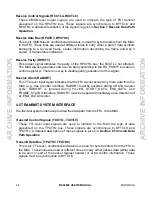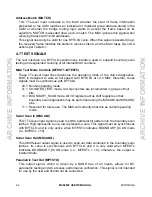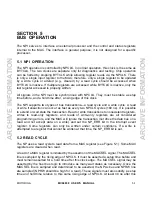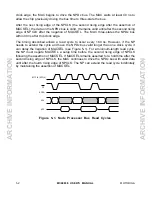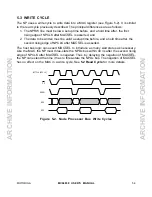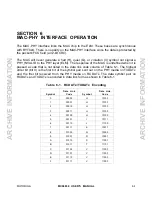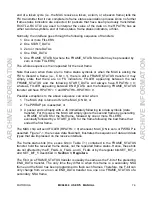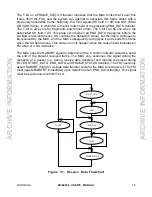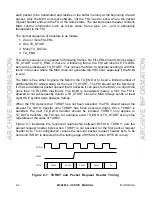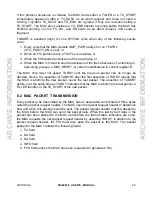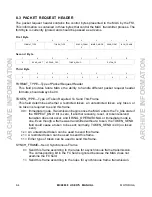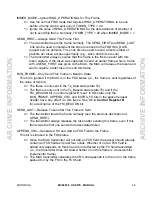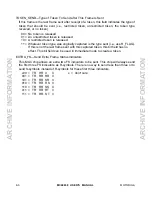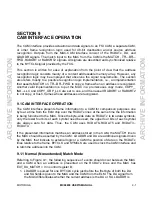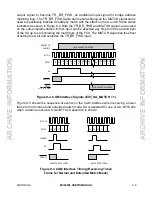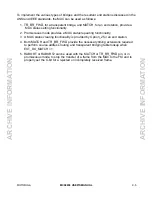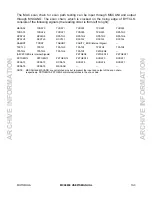
MOTOROLA
MC68838 USER’S MANUAL
8-1
SECTION 8
TRANSMIT DATA PATH OPERATION
The receive data path portion and transmit data path portion of the MAC work
independently of each other except for signals that must be passed between the two
sections of the device. In fact, the receive data path portion does not receive any signals
from the transmit data path portion. The signals that the transmit data path portion
receives from the receive data path portion are as follows:
•
The transmitter FSM receives 11 event signals from the receiver FSM as described
in the FDDI MAC standard. In addition, it uses the current values of the frame status
flags.
•
The timer logic block receives an enable/disable TVX signal and a reset TVX timer
signal from the receiver FSM. In addition, the timer logic block can set the T_BID_RC
register field within itself via a connection to the receive data path.
•
The repeat function is connected to the receive data path that can read the status
fIags.
•
The address and target request time register block within the address and target
request time comparison logic can be selected to transmit my short address register,
my long address register, or target request time (via the TX MUX) to the PHY (ELM)
when the MAC sends either special void frames or internally generated claim and
beacon frames.
8.1 TRANSMIT DATA PATH CONTROL
The following list summarizes the interpretation of TPATHx as per the state of TXCTL1–
TXCTL0:
00 = FILLER—TPATHx is unspecified.
01 = TX_START—TPATHx contains the first byte of the packet request header. Only
a second TX_START, TX_DATA, or TX_END can follow this.
10= TX_END—TPATHx = AxxxMxxx, where x is don't care. If A = l, then the MAC
should abort the transmission of the packet (i.e., turn it into a fragment by
sending IDLEs); if A = 0, then the MAC should normally end this frame (i.e.,
append CRC, T-symbol, and frame status symbols). When M = 1, the FSI has
more packets ready to send.
11 = TX_DATA—TPATHx contains the second and third byte of the packet request
header or frame data. TX_START can follow this until TXRDY is asserted.
TX_DATA or TX_END can always follow this.
The FSI requests the token by transferring the packet request header to the MAC. The
packet request header, which consists of three bytes of information, is associated with
ARCHIVE INFORMA
TION
ARCHIVE INFORMA
TION
Summary of Contents for MC68838
Page 20: ...2 8 MC68838 USER S MANUAL MOTOROLA ARCHIVE INFORMATION ARCHIVE INFORMATION ...
Page 63: ...5 4 MC68838 USER S MANUAL MOTOROLA ARCHIVE INFORMATION ARCHIVE INFORMATION ...
Page 65: ...6 2 MC68838 USER S MANUAL MOTOROLA ARCHIVE INFORMATION ARCHIVE INFORMATION ...
Page 82: ...9 6 MC68838 USER S MANUAL MOTOROLA ARCHIVE INFORMATION ARCHIVE INFORMATION ...
Page 86: ...10 4 MC68838 USER S MANUAL MOTOROLA ARCHIVE INFORMATION ARCHIVE INFORMATION ...
Page 98: ...12 6 MC68838 USER S MANUAL MOTOROLA ARCHIVE INFORMATION ARCHIVE INFORMATION ...

